
(Fig.1) K' observer's frame (= x', y', z') is moving at a velocity v to the right (= in the x direction ) relative to the rest frame K observer (= x, y, z ).

In the upper Fig.1, K' observer in K' coordinate (= x', y', z' ) is moving at a velocity v in the x direction with respect to the stationary K observer in K coordinate (= x, y, z ).
According to unphysical Einstein relativity, differently-moving observers (= K in K frame, K' in K' frame ) measure different clock times (= time t measured by K, different time t' measured by K' ) and coordinates (= the position of a thing is x,y,z measured by the stationary K, the position of the same thing is different x' y' z' measured by the moving K' ).
(Fig.2) Light emitted from the origin (x = x' = 0) appears to be traveling at the constant speed c, seen both by the stationary K and the moving K' ?
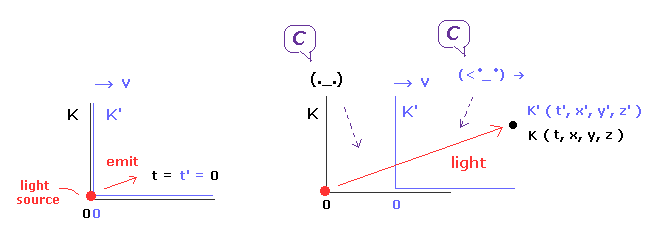
(Fig.3) Light speed must be always c seen by any observers including a stationary K and a K' moving at a velocity of v in x direction in paradoxical relativity.
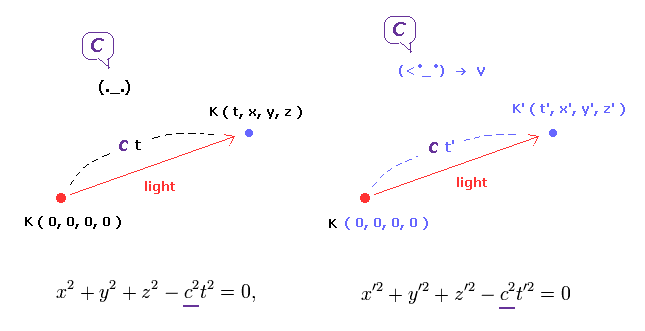
It is said that Michelson-Morley experiment showed the light speed is always the constant c (= to be correct, the light speed in air medium is c/n, n is refractive index ) in any directions, which rejected only the existence of the absolute luminiferous aether Not moving with the earth.
In fact, textbooks and the media hide the important fact that light can travel faster or slower than light speed c in Sagnac effect disproving Einstein relativity, and Michelson-Morley and star aberration completely agree with light medium (= ether ) moving with the earth where the measured light speed is constant with respect to the earth rotating around Sun.
Einstein jumped to the wrong conclusion that the luminiferous ether (= medium in space ) does not exist ( this-p.10 ).
And his special relativity is based on the postulate that the light speed must be always the same c, as measured by any moving observers, whether seen by a stationary observer K (= time t and coordinate x,y,z in K frame ) or K' moving at a velocity v (= time t' and coordinate x',y',z' in K' frame ), which led to (unphysical) Lorentz transformation of spacetime ( this p.18-19 ) without the ether or medium.
↑ Lorentz transformation used in Einstein relativity was originally introduced to explain aether theory contradicting relativity, though.
(Fig.4) (unphysical) Relativistic Lorentz transformation between the stationary K coordinate (= t, x, y, z ) and the K' coordinate (= t', x', y', z' ) moving at a velocity v
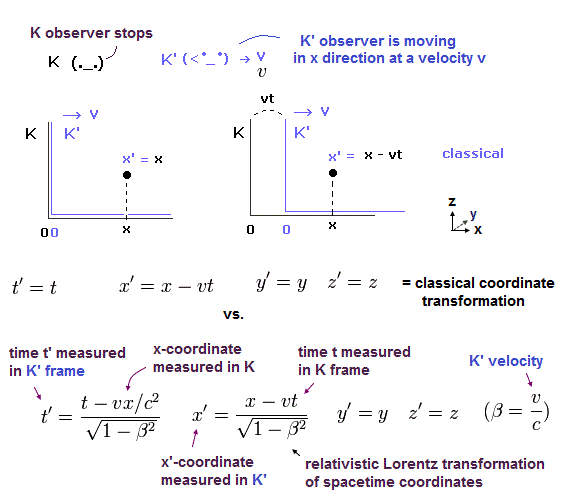
As shown in the upper Fig.2, the light is emitted from the light source at the origin (= x = x' = 0 ) at the time t = t' = 0.
This light arrives at (x,y,z) at the time t seen by the stationary K observer (= K frame or coordinate ), which point corresponds to the coordinate of (x',y',z') at the time t' seen by the moving K' observer (= K' coordinate or frame ).
↑ In the unrealistic Einstein relativity, clock times run differently measured by different observers, the stationary K (= time t ) and the moving K' (= time t' ).
Einstein special relativity tries to rely on (unphysical) Lorentz transformation between the stationary K coordinate (= time t, space x,y,z ) and the K' coordinate moving at a velocity v in x direction (= time t', space x',y',z' ) to explain the unphysically constant light speed c seen by any observers.
(Fig.5) Relativistic Lorentz transformation satisfies the equations of the same light speed c both in the stationary K observer's coordinate and the K' observer's coordinate moving at a velocity v in x direction.
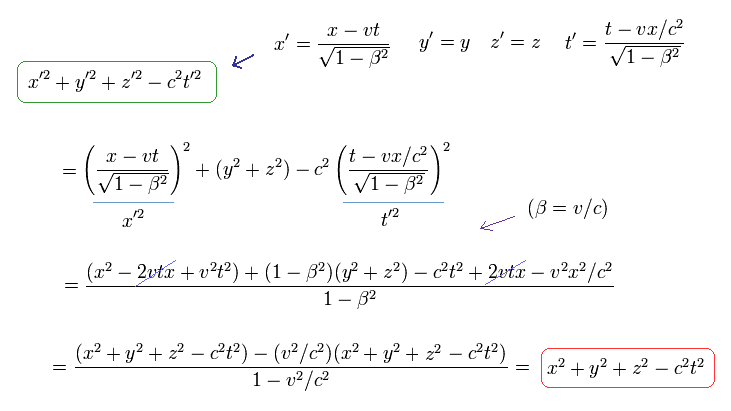
(Fig.6) Light speed is always "c" in any frames under Lorentz transformation.
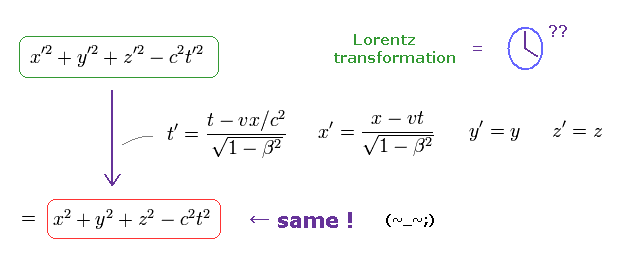
The relativistic Lorentz transformation relation (= unphysical space x,y,z, time t transformation between different observers ) satisfies two equations of the light speed being always the same c seen by the K observer at rest and the K' observer moving at a velocity v in x direction.
(Fig.7) K sees K' moving, but K' sees K moving in the opposite direction. ← Which K or K' is moving is uncertain, paradoxical in Einstein relativity.
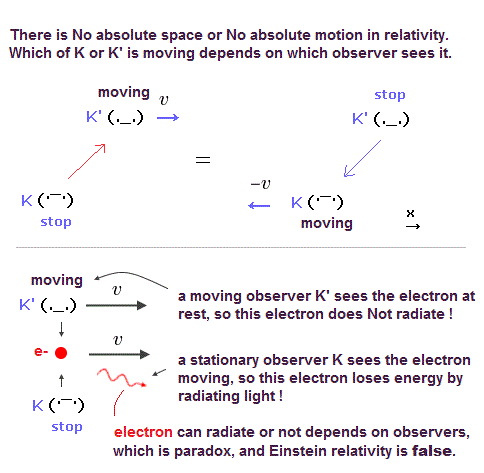
In the unphysical Einstein special relativity, there is No absolute frame (= No real medium relative to which the object is moving ).
As shown in the upper Fig.7, the stationary K sees K' moving in x direction at a velocity of v.
But seen by K', K is moving in the opposite -x direction at a velocity v. ← Which is moving K or K' is uncertain, which causes serious relativistic paradoxes.
For example, the stationary K sees an electron (= e- ) moving at a velocity in x direction and losing its kinetic energy by radiating light energy.
But seen by K' moving at the same velocity as the moving electron, the electron appears to stop with No kinetic energy to lose, but the electron at rest (= No kinetic energy ) is paradoxically losing (kinetic) energy by radiating light (= but the electron unrealistically increases its speed after losing the kinetic energy, seen by K' ! ).
What's worse, seen by the moving K', the stationary electron with No kinetic energy appears to increase its kinetic energy by losing light (= kinetic ) energy, which is clearly paradox showing Einstein relativity is wrong.
If we accept the real medium (= moving with the earth compatible with aberration ) in space (= by rejecting Einstein relativity ), this fatal kinetic energy and de Broglie wave paradox can be solved.
Because we can say the electron moving relative to the medium has kinetic energy and causes de Broglie wave, irrelevant to observers.
(Fig.8) The stationary K sees K' moving in x direction, while the K' sees K moving in the opposite direction.

In the upper Fig.8, the stationary K (= K coordinate is time t, space x,y,z ) sees K' (= K' coordinate is time t', space x',y,z' ) moving in x direction at a velocity v.
Seen by K' (= K' rest frame ), the K is moving in the opposite direction (= velocity -v ).
Special relativity demands the light speed should be always the constant c seen by K and K', which needs the paradoxical Lorentz transformation.
In Fig.8-lower, this Lorentz transformation can be expressed by two versions (= normal and inverse ) of equations (= if you insert one equation into the other, you can find these two Lorentz equations are the same thing. )
(Fig.9) A moving clock K' time t' runs slower than a stationary clock K time t according to the paradoxical Einstein special relativity.
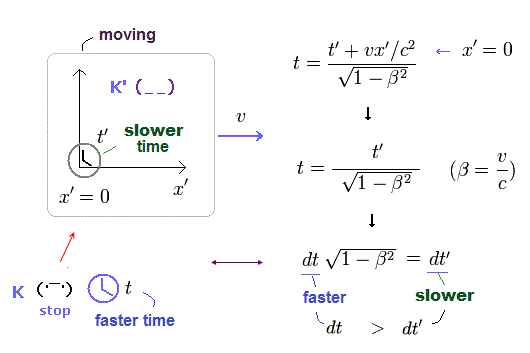
According to the unphysical special relativity, a moving clock appears to tick slower than a stationary clock.
In the upper Fig.9, K' clock fixed at x' = 0 (= x' coordinate is moving relative to x coordinate) is moving in x direction at a velocity v relative to a stationary K clock.
By inserting x' = 0 (= position of the moving K' clock ) into the Lorentz transformation equation of Fig.8-lower, we get the time dilation where the moving K' time t' is slower than the stationary K time t, as shown in Fig.9-lower ( this-p.1-time dilation~p.2, this-middle, this p.4-upper ).
This special relativistic time dilation of a moving clock running slower causes serious twin paradox, which can Not be solved.
(Fig.10) Seen by K', K clock is moving and running slower.
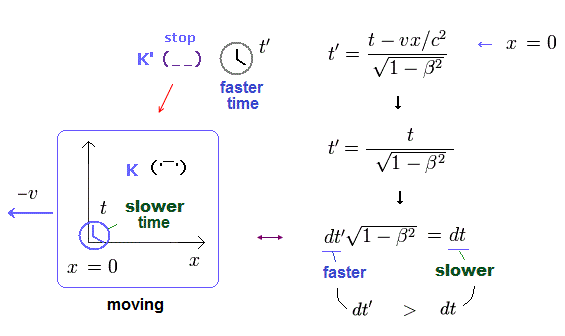
Seen by the moving K', the stationary K clock is moving in the opposite -x direction at a velocity v, so K clock is running slower, according to the paradoxical Einstein relativity.
Inserting x = 0 (= K clock is fixed at x = 0 position, and this whole x coordinate is moving in -x direction ) into Lorentz transformation equation, we show the K clock dt is slower than the K' clock dt', as shown in the upper Fig.10
(Fig.11) Which clock K or K' is moving and ticking slower is paradoxical.
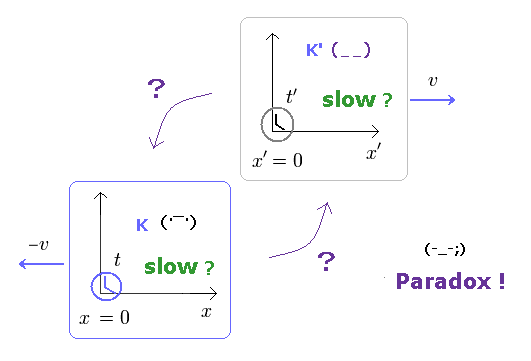
As shown in Fig.9 and Fig.10, which clock K and K' is moving and running slower is paradoxical and uncertain, because when seen by K (or K' ), the other K' (or K ) clock is moving and running slower.
This is twin paradox, which cannot be solved either by special or general relativity, so Einstein relativistic theory proved to be wrong.
All alleged (dubious) experiments showing relativistic time dilation were irrelevant to Einstein relativity due to this twin paradox.
Relativistic time dilation is too small to measure accurately, which cannot be used to prove the relativistic theory (= clocks are influenced by various other effects such as atmospheric pressure, temperature.. irrelevant to Einstein relativity ).
GPS clock frequently causes errors (= disagreeing with Einstein relativistic theory ), which must be corrected by being compared with the station clock on the earth, which is irrelevant to Einstein relativity.
Muons with higher speed (= higher energy ) can naturally move or penetrate longer, which is irrelevant to the illusory muon's lifetime elongated by the paradoxical relativistic time dilation.
(Fig.12) Moving objects are contracted ? → paradox.
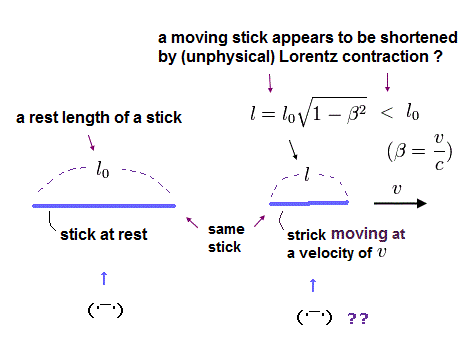
According to the unphysical Einstein relativity, a moving stick or a moving thing is shorter than a stick at rest, which is called Lorentz length contraction ( this-lower ).
But in the relativistic world with no absolute frame, which stick is moving is uncertain, changed depends on observers, which also causes serious relativistic paradox such as kinetic energy and de Broglie wave.
(Fig.13) A stick length at rest is l0 (= this stick is moving with K' ), which appears to be shorter (to l ) in a moving stick seen by the stationary K ?
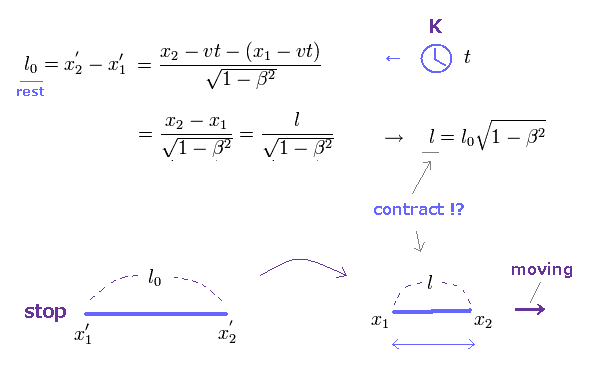
In the upper Fig.13, the length of a stick at rest with respect to K' is l0.
This stick and K' observer are moving together in x direction at a velocity of v with respect to the stationary K observer.
Using Lorentz transformation and the stick's position (= both ends of this stick remain in x2' and x1' in K' ), we show the length of this stick that is moving with respect to K appears to be shorter than the original length of l0
This relativistic Lorentz contraction causes Ehrenfest (= rotating disc's circumference ) paradox fatal to Einstein relativity.
The recent overhyped news is only about the fake relativistic Lorentz contraction under the artificial unreal light speed of only 2 meters per seconds ( this-8th-paragraph, this-middle-Snapshots across time reveal the impossible ).
This-p.2-Reviewer #2 says
"even though it is of course Not an actual relativistic
experiment"
"The visualization of relativistic effect is effectively achieved by using an ultra-fast photographic technique, which allows to simulate a very slow speed of light (= only fake 2m/s light speed )"
↑ This-p.3-Fig.3b,c used fake Lorentz-length contracted sphere and cube that are already contracted before moving.
See Aberration is compatible with aether dragged by the earth.
See Fizeau experiment agrees with aether dragged by the earth
See Transverse Doppler effect irrelevant to relativity.
(Fig.14) Clock time (= t0 ) nearer the Earth with mass M is slower than the clock time (= tf ) distant from the Earth with No gravity ?
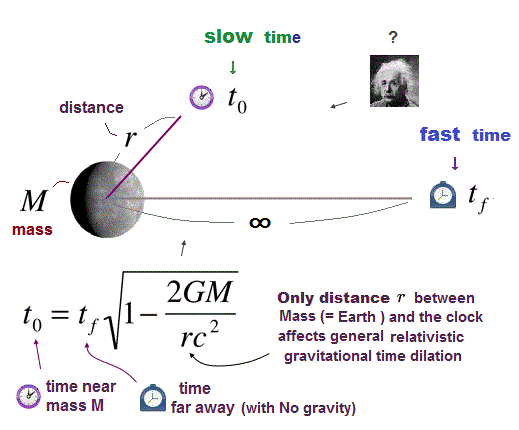
Einstein general relativity claims the clock time nearer to the Earth with mass M is slower due to greater gravity ( this middle, this p.15 ).
Time t0 at a point which is separated from the Earth's center by the distance r is expressed like the upper Fig.14 using the gravitational potential (= -GM/r, this p.5 ).
The point is this gravitational time dilation is simple, which depends only on the distance (= r ) between the clock's position and the Earth's center or gravitational potential (= other factors such as the gravitational constant G, the Earth's mass M, the light speed c are the constant fixed values ).
This general relativistic gravitational time dilation causes serious paradox of black hole (= imaginary time ).
As shown in the gravitational red or blue shift which can be explained by ordinary classical gravitational potential energy conservation law irrelevant to relativity, the atomic clock's light frequency is naturally influenced by gravity (= atomic clock's light speed or frequency is higher in upper place with weaker grapvity, lower pressure of the atmosphere or the medium mediating gravity ), which has nothing to do Einstein gravitational time dilation.
(Fig.15) Einstein relativistic time dilation in GPS ?
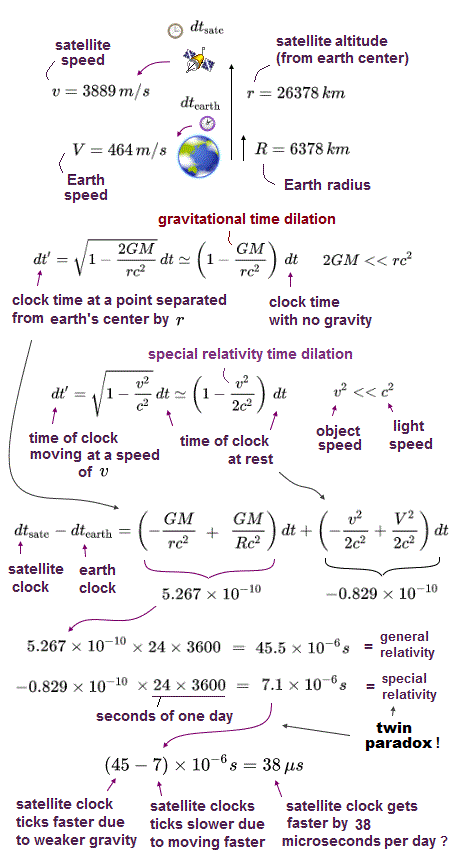
The actual GPS satellite's atomic clock completely disobeys Einstein relativistic time dilation, so GPS clock causes many unpredictable errors (= disagreeing with relativistic prediction ) which must be constantly corrected by the ground station's clock empirically.
But the textbooks often use the misleading case of a GPS satellite moving at a velocity of 14000 km/hr (= 3889 m/s ) at an altitude of 20000 km, so the satellite's distance from the Earth center is r = 20000km + 6378 km (= Earth's radius R ).
This satellite's clock is said to run faster than the Earth's clock by 45 microseconds per day because the gravitational time dilation is weaker at the higher altitude (= greater distance r = 26378 km from the Earth center ) than the Earth's surface (= distance from the Earth center is Earth's radius = 6378 km ).
And this satellite's clock is said to run slower by 7 microseconds (= μs ) per day because the satellite is moving faster (= satellite's speed is about 14000 km/hr = 3889 m/s ) than the Earth's surface (= Earth rotation speed is 1670 km/hr = 464 m/s ).
Hence, the satellite's clock is said to run faster by the total 45 μs - 7 μs = 38 μs than the clock on the Earth's surface per day ( this p.23-24 ) .
But as I said, this GPS time special relativistic time dilation allegedly caused by moving clocks cannot avoid the fatal twin paradox, so Einstein relativity is false.
(Fig.16) GPS satellite cannot avoid fatal twin time paradox, so Einstein relativity is false.
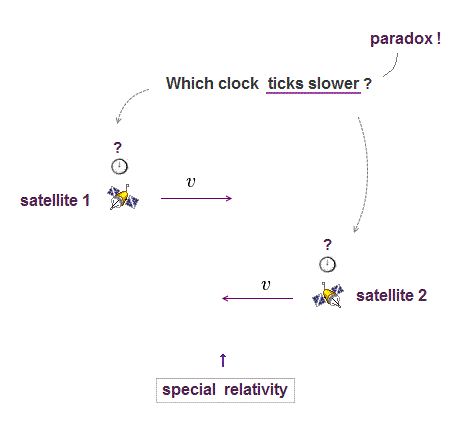
See twin paradox is real, Einstein is false.
Spin
Lorentz
force.
Right angle
paradox

Feel free to link to this site.